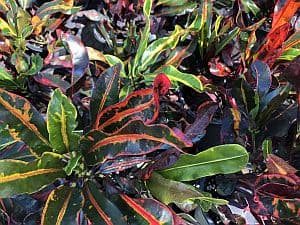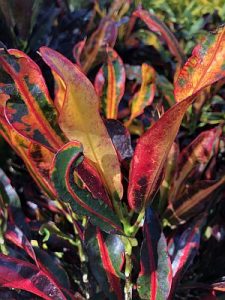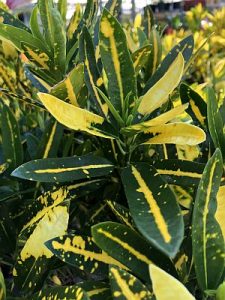(Image above: ‘Gold Dust’)
Codiaeum variegatum
Codiaeum variegatum is commonly known as Croton or variegated Croton. You may see this plant everywhere this time of year. We see them in summer months also but they offer bold color that is especially noticed and suitable for fall decor. The foliage is where the show comes from with combinations of yellow, orange, red and green coloring. The foliage is deeply veined and comes in various sizes and shapes depending on the cultivar. It has inconspicuous flowers and often times we don’t notice or think about the flowers at all. Croton is a tropical evergreen.
Croton is a member of the Euphorbiacea or spurge family. Some Croton have medicinal uses such as Croton tiglium oil. The Chinese have used it to heal legions and treat severe constipation. Native people of the Amazon use Croton lechleri as a liquid bandage and other purposed by the natives. Cascarilla (Croton eluteria) bark is a flavoring in the liquor Campari and Vermouth. Croton nuts from Croton megalocarpus are used as a source of biofuel.
Croton trees are used as a windbreak in Kenya. They make a statement as a mass planting, in large containers as a specimen and make a tropical foliage show. The genus is pantropical with some species extending into temperate areas. In Madagascar, up to 150 croton species are endemic to that area.
(Images above: [left] ‘Mamey’; [center] ‘Petra’; [right] ‘Gold Dust’)
Croton will color more and grow best outside in full sun. Keep smaller more tender plants indoors during freezing temperatures. Large plants can tolerate freezing weather. If it freezes outside, you will need to protect it from frost or pot it up to bring indoors. Croton requires as much light as possible indoors. Spindly stems on plants taken indoors may be cut back 10-12 inches from the soil during winter. They should be placed back outdoors in the summer. Plant new plants in the summer fertilizing monthly with a complete fertilizer and water often in summer, it is recommended to reduce water and fertilizer when plants are grown indoors.

Croton may need to be sprayed for aphids, mealy buds and spider mites. Plants may drop leaves when moved indoors or as tender plants are moved outside too quickly. So slowly acclimate tender plants outdoors starting in summer. Propagation is done by taking cuttings in December and January.
(Image right: ‘Mamey’)

By Karen Blackburn




